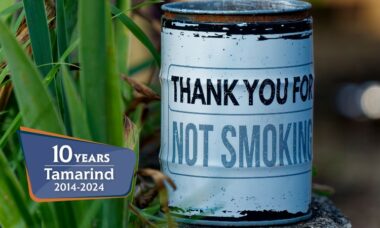 This is part of a series of articles celebrating the tenth anniversary of Tamarind Intelligence.
This is part of a series of articles celebrating the tenth anniversary of Tamarind Intelligence.
Novel tobacco and nicotine products, such as heated tobacco, nicotine pouches and herbal heated sticks, have seen a significant evolution in the past decade.
They have had an impact on the whole market, which expanded globally despite facing several regulatory issues, including flavour bans, product restrictions and taxation.
Several new devices for heated tobacco products (HTPs) were introduced by various companies, each offering different designs, features and technologies aimed at improving the user experience and reducing harm compared to combustible cigarettes.
Technological advancements in heating mechanisms, battery life, temperature control and safety features have also helped to provide a more consistent experience for users. Scientific studies have found that HTPs help to minimise potential health risks associated with smoking.
PMI paved the way for others to get into the game
Philip Morris International (PMI) introduced Iqos 2.2 in 2014, and it made its debut with pilot rollouts in Italy and Japan. By 2016, the Iqos brand had expanded to 15 countries, and 2017 saw the most significant growth, with launches in 18 new countries, including South Korea, which is currently one of the leading markets on the HTP landscape. From 2018 to 2021, Iqos continued its expansion, reaching 30 additional markets, among them more populated countries such as the Philippines and Mexico. Today, according to TobaccoIntelligence estimates, Iqos holds around a 75% share of the global heated tobacco market by value.
The groundwork done by PMI on increasing public awareness of tobacco alternatives was a benefit that other tobacco companies could leverage later.
In 2016, British American Tobacco (BAT) launched its first heated tobacco device, Glo, in Japan. While 2017 was a year of strong geographical expansion for Iqos, 2018 saw Glo launch in several countries, entering nine markets, all of which had already been penetrated by Iqos.
KT&G’s Lil, meanwhile, marked its entry into the market by launching its first device on domestic soil in South Korea in 2017. The turning point of expansion came in 2020 when, following KT&G’s strategic distribution alliance with PMI, Lil devices proliferated across 28 countries between over the next two years. This extensive growth was made possible by the established market presence that PMI had already cultivated.
The Ploom HTP from Japan Tobacco International (JTI) entered the scene in 2019, with the launch of Ploom S in Japan and South Korea. In 2020, Ploom S expanded its reach into markets where its hybrid products had been launched, including Italy and the UK. Today, Ploom is present in 16 markets, and JTI has formulated plans to expand to 40 markets by the end of 2026.
Imperial Brands’ Pulze launched in 2019, starting operations in Japan. Over the past three years, Pulze has strategically expanded in the European region, selectively targeting countries where heated tobacco is already prevalent, other brands have established a presence, and the smoking rate exceeds 20%.
According to TobaccoIntelligence estimates, the global heated tobacco market size was at $28bn in 2023. The market has grown since 2019 by a 24% compound annual rate and is forecasted to reach over $30bn in 2024.
Big changes in European HTP regulatory frameworks
Regulatory frameworks around HTPs have also evolved, with some countries implementing specific regulations for these products. During the past decade, there have been more and more restrictions on flavours, with an official ban on them in HTPs across Europe following the publication in the EU Official Journal of Commission Delegated Directive (EU) 2022/2100 on 3rd November 2022. In Europe, Austria and Poland are the only countries where the ban has not been adopted or discussed, whilst in other countries, including Denmark, the Czech Republic, Finland, France, Germany and Italy, the ban has already been adopted.
Major players in the European heated tobacco market are introducing herbal heated consumables – with brands including Veo, Levia and iSenzia – ahead of the EU-wide heated tobacco flavour ban. However, the future importance of herbal heated products within the EU and their potential expansion to regions with different regulations remains uncertain.
Despite these products being relatively new, though, they are already attracting the attention of regulators, as shown by recent events in Italy, where herbal sticks would be tracked and traced the same way as traditional cigarettes and heated tobacco sticks starting from May this year, in a move against the black market.
Italy’s Customs and Monopolies Agency (ADM) recently reviewed the characteristics of tax stamps for tobacco products, which, starting from 20th May this year, will be mandatory for HTPs and, TobaccoIntelligence understands, now for herbal heated products as well. A spokesperson from BAT in Italy told TobaccoIntelligence that the company considered this a positive development.
Modern oral nicotine products and herbal heated tobacco sticks
Over the past decade, modern oral nicotine products have also undergone significant evolution, driven by advancements in technology, changes in consumer preferences, and regulatory developments. Manufacturers have introduced a variety of new formulations, launching a wide variety of flavours to diverse tastes.
Modern oral nicotine products have become more widely available in recent years, with expanded distribution channels, including online platforms and retail stores. This increased availability has contributed to greater consumer awareness and acceptance of these products as alternatives to traditional tobacco products.
Last year, nicotine pouches seemed to be the universal positive for Big Tobacco, with oral tobacco categories making increasingly important contributions to all the companies involved in that area. Heated tobacco saw the addition of players such as KT&G and JTI, but experienced a slightly more mixed overall return.
Raising and finding solutions to environmental issues
Along with the evolution of novel tobacco and nicotine products, there are also environmental challenges associated with their production and use, such as their contribution to waste generation and chemical pollution. The UK’s recent announcement to ban disposable products could certainly be followed by other European countries. The debate around disposables has intensified throughout Europe since March 2023, with under-age vaping and environmental concerns being the two main arguments of the debate.
At the tenth Conference of the Parties (COP10) to the World Health Organization Framework Convention on Tobacco Control (WHO FCTC), held in Panama in February this year, countries were expected to get to grips with emerging alternative tobacco products, leading many involved with harm reduction to worry that severe restrictions would be recommended.
The WHO FCTC touted the adoption of “historic decisions” that would have impacted the global industry. But the Convention Secretariat told TobaccoIngelligence: “There were no standalone decisions made at [COP10] regarding HTPs or electronic nicotine and non-nicotine delivery systems (ENDS and ENNDS) – sometimes referred to as electronic cigarettes – or the industries that produce such products.”
In the wake of the conference, the WHO FCTC issued a statement explaining that during COP10, a decision was made to implement Article 18, which addresses the impact of the tobacco industry on the environment. The organisation said that the event “concluded with a far-reaching decision that will protect the environment and the health of people throughout the world from the ravages of tobacco”.
– Antonia Di Lorenzo TobaccoIntelligence
Photo: Koa’link







